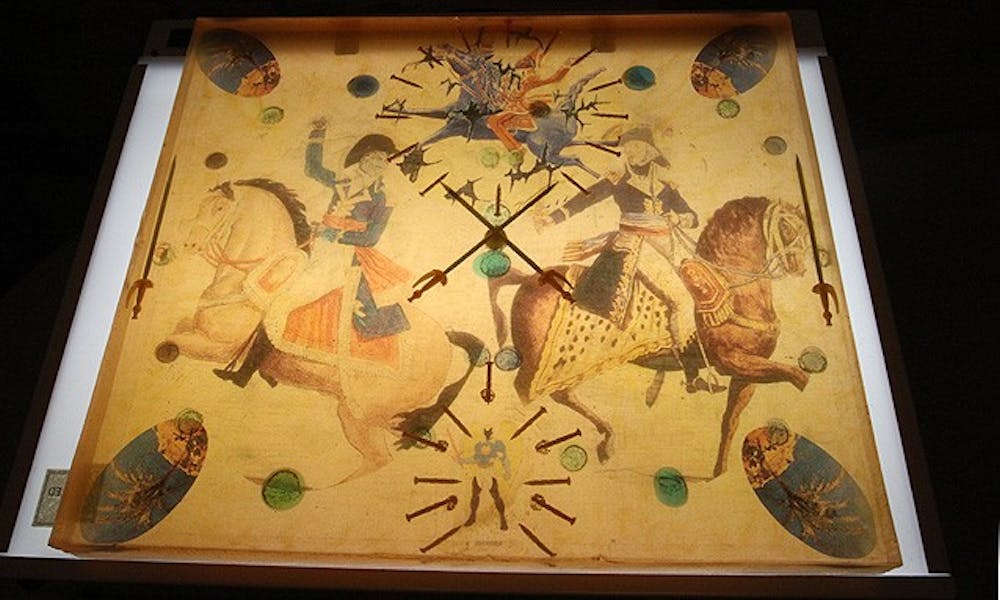Haitian artist Edouard Duval-Carrie understands the challenge of summing up a breadth of knowledge into one visual whole.
Duval-Carrie oversaw “Haiti: History Embedded in Amber,” a collaborative piece depicting the visual history of the nation as part of the 2010-2011 Provost’s Lecture Series on “Natural Disaster and Human Responses.” Duval-Carrie worked in conjunction with the Franklin Humanities Institute Haiti Lab, the Office of the Provost and the Vice Provost for the Arts.
Duval-Carrie said his work serves to push the boundaries of knowledge and perceptions about his homeland.
“Haiti has been so problematic a place, that people have all sorts of misconceptions and prejudices,” he said. “I want them to realize it is a complex place, with a complex history. I want people to know it cannot be flattened into one platitude.”
The project touches on a variety of issues including trauma resolution and Haitians’ understanding of their own history.
“It’s an exercise of understanding ‘the other,’” Duval-Carrie said. “This is what studying is all about—it permits us to confront so many different things.”
He added that he is delighted an institution of Duke’s caliber is addressing these issues.
The interdisciplinary backgrounds of the participants highlight the richness of the piece. Student artists and members of the Duke faculty constructed a series of amber-colored lacquered blocks, each containing layers of historical and contemporary images and objects. Collectively, the blocks piece together a portrait of Haiti by highlighting the history that has been swept under the rug and introducing images of a nation recovering from disaster.
“We chose an amber lacquer because when animals get stuck in amber, it’s how we learn about our history,” Duval-Carrie said. “In this case, it is a metaphor for studying things in the past in an interesting way and giving us clues about what happened.”
Student artists enrolled in an independent study through the Department of Art, Art History and Visual Studies and designed their blocks over the course of the Fall semester.
Freshman Zack Green, the student documentary intern for the independent study, said the beginning sessions were structured more like a history class than an art project.
“There was a lot of brainstorming about what parts of the culture they wanted to apply,” Green said. “The piece is not just about the earthquake. The project may have happened because of the disaster, but that became one of the many things incorporated into the blocks.”
Student artist Maria Arroyo, a sophomore, said she drew inspiration for her piece from these beginning history lessons.
“My block started out from our discussions on [Haitian] Vodou and how it is a hybrid religion that appropriates images from other cultures,” she said. “I used a composite of photos from Haiti to recreate portraits of two of the deities.”
Arroyo added that she found the particular images used in her block by “flipping through image after image,” including photos of Duval-Carrie’s work and pictures taken by faculty members during a research trip to Haiti. She then photoshopped her images and printed them onto transparencies.
Finally, Jessye McDowell, research assistant for the project, poured resin over the photos and various objects selected for the block, said Deborah Jenson, co-director of the Haiti Lab. This process was repeated several times to create multi-dimensional layers.
Duval-Carrie visited Duke three times throughout the semester to help guide the students as they turned their ideas into “amber blocks,” Jenson said.
“He had a good enthusiasm for everyone’s ideas,” Arroyo said. “It was nice to hear his input.”
Alongside students, several members of the Duke faculty also contributed to the project.
Merrill Shatzman, faculty artist advisor and associate professor of the practice of visual arts, said her favorite part of the project was seeing how everyone brought their own creativity to their blocks.
Get The Chronicle straight to your inbox
Sign up for our weekly newsletter. Cancel at any time.
“Students of history approached the project very differently than art and art history students,” Shatzman said. “Each kid found their niché.... It made it such a full experience.”
The completed work, titled “Haiti: History Embedded in Amber”—along with documentary video and photographs of the block-making process—were unveiled Tuesday, December 7, as part of Edouard Duval-Carrie’s presentation for the Provost’s Lecture Series. The installation will be displayed in the Franklin Humanities Institute.

